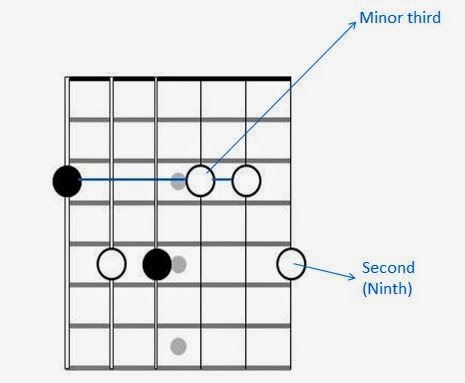In the last two lessons, you were told about the relative positions of the major scale degrees with respect to a reference (root) note. In this lesson you will be witnessing how you can use it to do almost anything on your fret board and most importantly how you can form a chord shape, scales, and arpeggios instantly.
Let's start with a chord first. Suppose you already know what goes a G major chord look like. A diagram is given below in the bar chord form.
Let's start with a chord first. Suppose you already know what goes a G major chord look like. A diagram is given below in the bar chord form.
Now you know it contains the degrees 1-3-5. Now if you were serious about the previous two lessons, you must be able to recognize where the root, the third and fifth are. Well, the root has already been dark filled. Now that you know this shape for G major and someone suddenly asks you to grab a G-minor add 9 chord. Now what? You have never seen that chord form! So does it mean that you will fail? No way!!! Here is what you need to do. Now let me show you where the third and fifth lie in this chord form.
Now you were asked to convert it into G minor add 9 chord. So what is the chord formula?
Its 1-b3-5-9 (9 is same as 2). So what changes you need to make in the above chord form? You need to change 3 to b3 which means you have to take the third one fret lower. And you have to add a second degree to make it a ninth chord. You already know where the second degree lies. Here is how the chord will look like.
See! how easy it gets to form any chord instantly even if you are hearing about it for the first time. Now let us apply the same concept to form a scale which you are hearing for the first time given you only know the formula. Lets take an uncommon scale, say the Japanese scale. The formula is 1-b2-4-5-b6. Lets create two shapes of this scale in the key of D. You already know where your respective degrees lie. The only thing you have to do is to shift the second and sixth degree by one fret down. That's it. See how it looks like in D key.
So see how easy it is to form scales instantly if you only know the formula. Now suppose you want to create an arpeggio shape. Let's say a major seventh arpeggio. So what will be the formula? It will be 1-3-5-7. So let us see how it will look like. Here is the diagram shown with root as G in the first position.
So you can create your own scales, chord shapes and arpeggios instantly. The best part is yet to come. And this is related to soloing. Suppose you have a chord progression Em-Bm-D-G. And now suppose you are totally clueless about which scale or mode to use. The one who knows scales and modes will know that this progressions fits in E Aeolian. One can use E minor scale, E minor pentatonic, C lydian, G major etc etc. But suppose you don't know all these things. Now what? Just know where do the E, B,D and G lie on the fretboard. And you are ready to rock. Because you already know an Em chord is 1-b3-5 with 1 as E. And you also know where the b3 and 5th would be with respect to E. Similarly is the case with Bm, D and G. So you know all your "MOST ACCURATE NOTES". This approach provides you the most accurate notes and you will be soloing while treating each chord separately which will be more harmonious and melodic as compared to the scale and modes approach. Try this method and practice it and make it a habit to solo using this concept. Also you should add other notes. Choose at random and see which fits in and which does not.





No comments:
Post a Comment